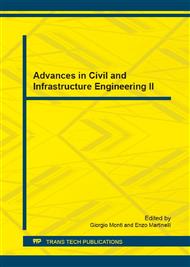[1]
EN 1998-1, 2005, Eurocode 8 - Design of structures for earthquake resistance. Part 1: General rules, seismic actions and rules for buildings.
DOI: 10.3403/03244372u
Google Scholar
[2]
EERI Earthquake Engineering Research Institute, 1984. Nonstructural Issues of Seismic Design and Construction, Berkeley, CA, USA.
Google Scholar
[3]
De Sortis A., Di Pasquale G., Dolce M., Gregolo S., Papa S., Rettore G.F., 2009. Linee guida per la riduzione della vulnerabilità di elementi non strutturali arredi e impianti, Presidenza del Consiglio dei Ministri Dipartimento della Protezione Civile (in Italian).
Google Scholar
[4]
SIA 261, 2003, Actions on Structures, Swiss Society of Engineers and Architects, Zurich, CH.
Google Scholar
[5]
ICC International Code Council, 2007. Seismic Provisions of the 2006 International Building Code (IBC). Western States Seismic Policy Council, Reno Nevada, USA.
Google Scholar
[6]
NBCC, 2005. National Building Code of Canada. Canadian Commission on Building and Fire Codes and National Research Council of Canada, Montreal, Ottawa, CA.
Google Scholar
[7]
Villaverde R., Chauduri S.R., 2008. Effect of Building Nonlinearity on Seismic Response of Nonstructural Components: A Parametric Study. Journal of Structural Engineering. 134(4), 661-670.
DOI: 10.1061/(asce)0733-9445(2008)134:4(661)
Google Scholar
[8]
Sullivan T.J., Calvi P.M., Nascimbene R., 2013. Towards improved floor spectra estimates for seismic design. Earthquakes and Structures, 4 (1).
DOI: 10.12989/eas.2013.4.1.109
Google Scholar
[9]
Filiatrault A., Sullivan T., 2014. Performance-based Seismic Design of Nonstructural Building Components: The Next Frontier of Earthquake Engineering, Earthquake Engineering and Engineering Vibration, Special Issue on the State-of-the-Art and Future Challenges of Earthquake Engineering, 13(1) Supplement, 17-46.
DOI: 10.1007/s11803-014-0238-9
Google Scholar
[10]
FEMA 356, 2000. Prestandard and commentary for the seismic rehabilitation of buildings. 1st edition.
Google Scholar
[11]
FEMA E-74, 2010. Reducing the risk of nonstructural earthquake damage, 4th edition.
Google Scholar
[12]
Whittaker, A. S., Soong, T. T., 2003, An Overview of Nonstructural Components Research at Three U. S. Earthquake Engineering Research Centers. ATC-29-2 Report. Applied Technology Council, Redwood City, CA, USA.
Google Scholar
[13]
FEMA 74, 1994. Reducing the risk of nonstructural earthquake damage, 3rd edition.
Google Scholar
[14]
ATC Applied Technology Council, 2008. Reducing the Risks of Nonstructural Earthquake Damage: State-of-the-Art and Practice Report, Redwood City, CA, USA.
Google Scholar
[15]
Lin J., Mahin S.A., 1985. Seismic Response of Light Subsystems on Inelastic Structures, Journal of Structural Engineering, 111(2), 400–417.
DOI: 10.1061/(asce)0733-9445(1985)111:2(400)
Google Scholar
[16]
Oropeza M., Favez P., Lestuzzi P., 2010. Seismic response of nonstructural components in case of nonlinear structures based on floor response spectra method, Bulletin of Earthquake Engineering, 8(2), 387-400.
DOI: 10.1007/s10518-009-9139-0
Google Scholar
[17]
Clough R. W., Penzien J., 1993. Dynamics of Structures, 2nd Edition, McGraw-Hill Book Co., Singapore.
Google Scholar
[18]
Miranda E., 2000. Inelastic Displacement Ratios for Structures on Firm Sites, ASCE Journal of Structural Engineering, 126(10), 1150-1158.
DOI: 10.1061/(asce)0733-9445(2000)126:10(1150)
Google Scholar
[19]
Taghavi S., Miranda E., 2008, Effect of interaction between primary and secondary systems on in-structure response spectra. Proceedings of the 14th World Conference on Earthquake Engineering, 12-17 October 2008, Beijing, China.
Google Scholar


